Menus
- Engine concepts from KTM, Triumph, Husqvarna and Kawasaki
- MOTORCYCLE – scoring / test result
- Technical specifications
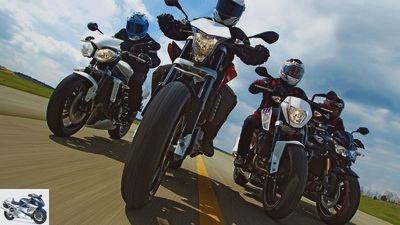
Gargolov
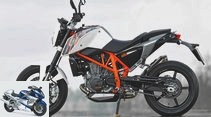
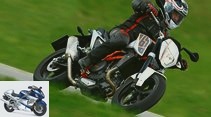
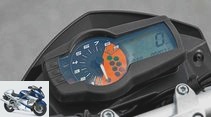
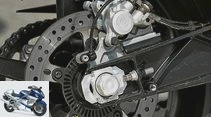
25th photos
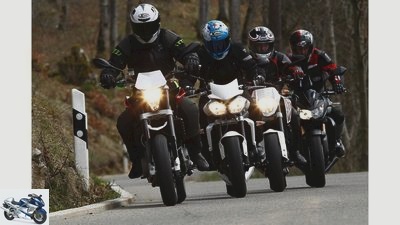
Gargolov
1/25
Husqvarna Nuda 900 R, Triumph Street Triple R, KTM 690 Duke and Kawasaki Z 750 R Black Edition. Bikes with different engine concepts in a fun bike comparison test.
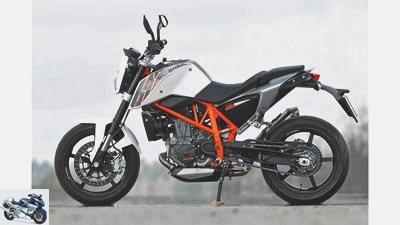
Gargolov
2/25
The single cylinder: KTM 690 Duke.
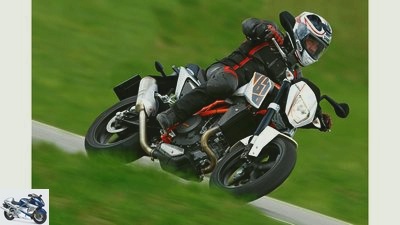
Gargolov
3/25
KTM 690 Duke.
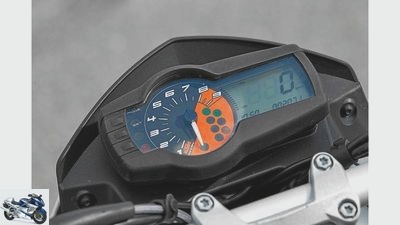
Gargolov
4/25
KTM 690 Duke: With the delicate instrument cluster, great importance was attached to the readability of engine speed and speed.
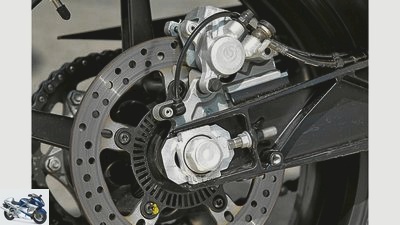
Gargolov
5/25
Good workmanship and attention to detail – valuable components and high-quality materials can be found everywhere.
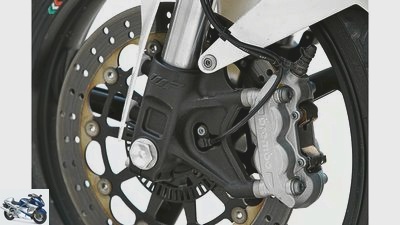
Gargolov
6/25
Radially bolted four-piston fixed caliper – optically and technically well made, but unfortunately overwhelmed in extreme situations.
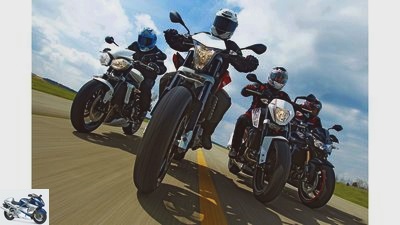
Gargolov
7/25
Triumph Street Triple R, Husqvarna Nuda 900 R, KTM 690 Duke and Kawasaki Z 750 R Black Edition.

Gargolov
8/25
The two-cylinder: Husqvarna Nuda 900 R.

Gargolov
9/25
Husqvarna Nuda 900 R.
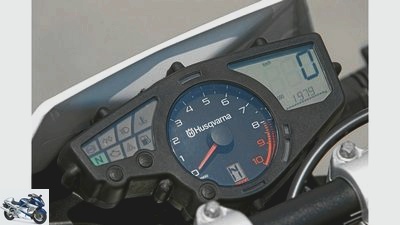
Gargolov
10/25
Even with a gear indicator, but the control buttons are quite fiddly to operate.
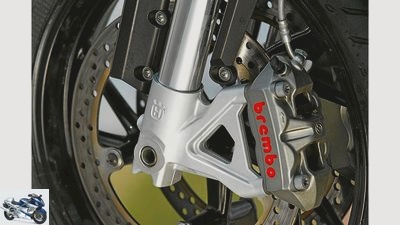
Gargolov
11/25
Stable, snappy, incredibly powerful: The monobloc Brembo calipers are a hit.
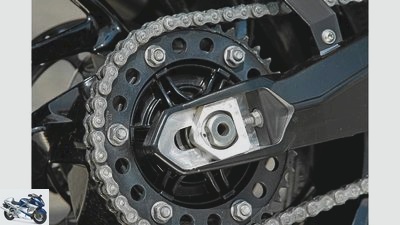
Gargolov
12/25
The frame and swing arm come directly from the BMW F 800 and have only been slightly modified for use in the Nuda.
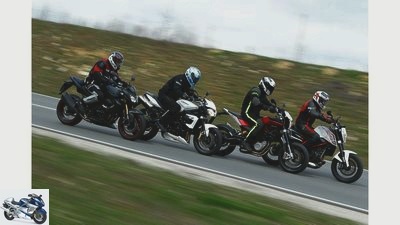
Gargolov
13/25
Kawasaki Z 750 R Black Edition, Triumph Street Triple R, Husqvarna Nuda 900 R and KTM 690 Duke.
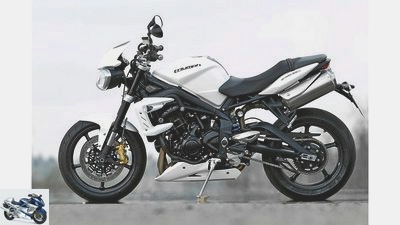
Gargolov
14/25
The rotary cylinder: Triumph Street Triple R..

Gargolov
15/25
Triumph Street Triple 675 R.
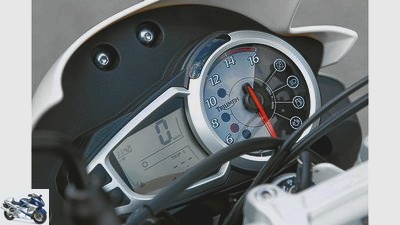
Gargolov
16/25
Triumph Street Triple 675 R: Easy to read, lots of information, but ultimately you want a fuel gauge.
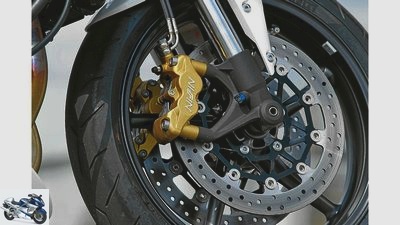
Gargolov
17/25
Triumph Street Triple 675 R: Braking without blame: The triple’s stoppers are fantastic, two fingers are enough, the effect is extreme.

Gargolov
18/25
Triumph Street Triple 675 R: The two rear silencers are unfavorably positioned in terms of their center of gravity.
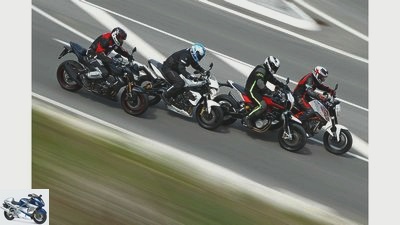
Gargolov
19/25
Kawasaki Z 750 R Black Edition, Triumph Street Triple R, Husqvarna Nuda 900 R and KTM 690 Duke.
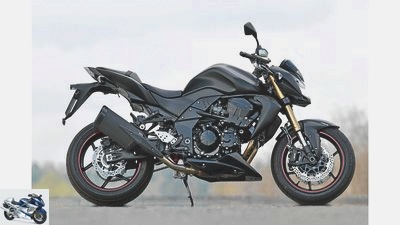
Gargolov
20/25
The four-cylinder: Kawasaki Z 750 R Black Edition.
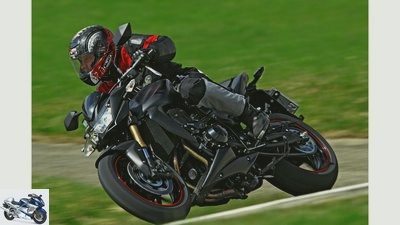
Gargolov
21/25
Kawasaki Z 750 R Black Edition.
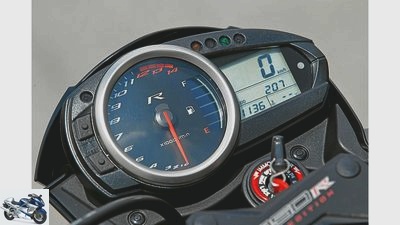
Gargolov
22/25
Kawasaki Z 750 R Black Edition: The only machine in comparison with an exact fuel gauge.
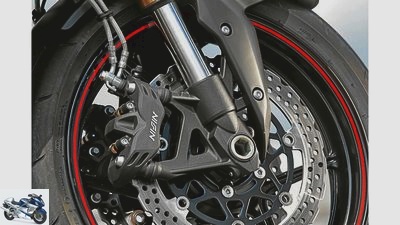
Gargolov
23/25
Kawasaki Z 750 R Black Edition: Front brake: technically up to date, comparatively duller than the competition, but foolproof.
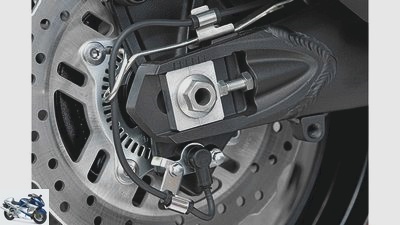
Gargolov
24/25
Kawasaki Z 750 R Black Edition: Couldn’t the cable for the ABS sensor have been laid a little nicer? Anyway, at least it has an ABS.
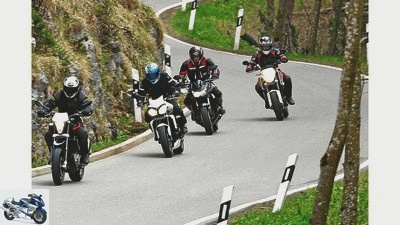
Gargolov
25/25
Husqvarna Nuda 900 R, Triumph Street Triple R, Kawasaki Z 750 R Black Edition and KTM 690 Duke. In the end, the balanced Triumph has the edge.
Concept comparison Funbikes 2012
Engine concepts from KTM, Triumph, Husqvarna and Kawasaki
Four engine concepts, one goal: have fun. Read here how the manufacturers achieve their goal in different ways or whether they even overshoot.
The eye has long since caught it. The radius wide. No grit, no trace of oil. Gray, rough asphalt that promises a lot of grip. Everything can be seen. So perfect conditions for following the ideal line. When you meet them. So take a bend and experience what motorcyclists like best: speed, lean angle, acceleration. But which concept is best served? Does a robust single-cylinder make its four-cylinder buddy look old in tight turns? Perhaps the ratio of power and weight is more important? Or is the truth ultimately in the chassis geometry? In search of answers, MOTORRAD sent four bikes with different engine concepts onto the slopes: the single-cylinder KTM 690 Duke, -Husqvarna’s new two-cylinder hammer Nuda 900 R, Triumph’s little three-cylinder sweeper Street Triple R and Kawasaki’s dashing Z 750 R with inline four-cylinder.
E.rstkontakt – seat sample. Compared to its predecessor, the new 690 Duke looks almost like a touring motorcycle. With the suspension travel cut and a modified saddle, you sit lower. But not more comfortable in the long run, because the edge of the newly designed, two-part bench prevents casual, sporty sliding around, as was the case on the old Duke. Especially big ones have their problems with this. In return, the petite Austrian pretends to be beginner-friendly right from the seat rehearsal. In contrast to the Nuda R, which shocks the newcomer with a seat height of 890 millimeters. Here you have to swing your leg up. But due to the narrow waist of the Nuda, even people who are 1.70 meters can still stand reasonably safe. Right from the first contact, the Nuda R appears hard, racist, uncompromising. This is due to the rock-hard seat, the motocross handlebars and of course the seat height. With the three-cylinder competition from Great Britain, however, one is not immediately sure. If you take a seat on Street Triple, the first thing you will find is a perfectly arranged workplace. Long legs or short ones? No matter. Fits.
Buy complete article

Concept comparison Funbikes 2012
Engine concepts from KTM, Triumph, Husqvarna and Kawasaki
Kawasaki, on the other hand, is getting on in years. You notice that when you first sit down. The frame and engine are wide, legs spread wide apart. The cranking of the handlebars somehow doesn’t work at all. What does that thing want? Not a race, not a tour – maybe an unsuccessful attempt to bend a pipe into a work of art? In addition, as with the Nuda, you sit ON and not IN the machine. With the difference that you will find much better ergonomics on the Nuda. If you should judge cornering ability by the seating position, then the Husqvarna and the Triumph are ahead here thanks to their active seating position and good contact with the machine.
The core pieces – engines. Thank you, KTM! While other manufacturers have retired their single-cylinder or offer it as a performance-neutered product, Austria has worked hard. The 690 cubic strong single lifts 70 hp, which together with a gross weight of only 163 kilograms promise a lot of propulsion. A double ignition installed since this year should both reduce fuel consumption and improve running characteristics. Little of that can be felt in this test copy. At 3.7 liters per 100 km, the 690 consumes little, but hardly less than its 654 cubic predecessor and runs only slightly more smoothly.
Gargolov
Kawasaki Z 750 R Black Edition, Triumph Street Triple R, Husqvarna Nuda 900 R and KTM 690 Duke.
Nothing works below 3000 rpm. The chain whips, the drive hacks at her as if she had to be severely punished. But after that, things really take off. Unstrained agile, but connected with robust vibrations, the single turns until its vigor is stopped by the limiter at 8400 rpm. Except for the range below 3000 rpm, the engine is extremely powerful, especially the punchy middle is impressive. At around 4500 rpm, the 690 unpacks a huge punch package. You never really want to turn it off, because the harsh vibrations in the last third of the speed are annoying. Of the three modes that can be selected (setting under the pillion seat), the standard and advanced modes make sense – in the latter, the response to throttle commands is more direct. The comfort zone of this drive is in the middle on the country road, between 3500 and 5500 rpm, in a relatively narrow window.
The exact opposite is provided by the Nuda engine, which cannot deny its constructive relationship with the BMW F800 unit. Both drives are manufactured by Rotax in Austria. Almost identical on the outside, the Husqvarna and Rotax technicians have given the bowels of the twin a radical cure: larger valves, new cylinder head, modified valve timing, 45 degrees crankshaft offset, 100 cubic meters more – the list is endless. Includes connecting rods, pistons, oil circuit, clutch, etc. This effort has paid off: the drive produces 105 hp at 8500 rpm. And while the BMW twin (85 hp at 7500 rpm) delivers its power uniformly bored and without a kick, its Husqvarna cousin appears livelier, more agile, bolder and stronger in all areas. It also reacts to gas commands like a lion that you force to wake up with a pointed stick. The Nuda R not only roars like a predator through its Lafranconi silencer at gas commands, it also dives off immediately. The usable speed range of the 900 is enormous. From 2000 rpm the Nuda-Twin marches off and increases permanently and above all evenly up to 9200 rpm. He never seems strained, turns casually and in the last third of the speed it really pours fuel on the fire. The downside: Due to a very short translation, you never really want to calm down, you always feel on the prowl, always on the attack – unsuitable for strolling, but the best prerequisite for tearing corners.
The street triple triplet has been providing good reasons for years that all good things come in threes. He hisses fantastically, runs smoothly, without denying a life of its own, and sweeps through the rev range with furious nonchalance. The British three-cylinder is almost as speed-hungry and revving as a four-cylinder, but on the other hand always delivers sufficient torque to the rear wheel – almost like a two-cylinder. But only almost. When remeasured, its torque output up to 5000 rpm is higher than that of the KTM and Kawasaki, but far below what the Nuda engine pushes.
The 675 is the smallest engine in this group, but with 106 hp at 11,700 rpm it does not need to hide in terms of performance. It delivers the same nominal power as the 748 cubic four-cylinder from Kawasaki. You have to like the way the Kawa drive delivers its power: nothing works without speed. Nothing at all! Sure, the motorcycle is moving forward. Somehow anyway. But if the clock is not at least 7000 rpm, there is no need to start overtaking. The drive is idle between 4000 and 7000 rpm. His performance is just enough to swim along in traffic. Only above 7000 tours does the four-cylinder really bite, the rev range that can be effectively used for speedy curve surfing is between 7000 and 12,500 tours. But who wants to be screeching all the time? As I said, you have to like it.
Gargolov
Kawasaki Z 750 R Black Edition, Triumph Street Triple R, Husqvarna Nuda 900 R and KTM 690 Duke.
Slopes – the salt in the soup. All four bikes come rushing towards the first tight bend at brisk country road pace. Experienced people drive through it at the apex at 50 km / h. Which machine is the fastest here and why? First it is time to brake. The Nuda and Street triple deliver first-class performances despite the lack of anti-lock braking systems. The braking effect of both machines is brutal, even with a two-finger pull. In contrast, the ABS-assisted stoppers on the Kawa and KTM, which are also good, have a toothless effect. Okay, we delayed, now it’s time to turn. The easiest, most direct and creamiest way is with the three-cylinder British woman. Why? Quite simply: The super-light and extremely handy Duke looks a little nervous in the end. Your handicap is the much too soft, underdamped shock absorber, which gives way even on small bumps, starts to pump and leads to unrest in the chassis.
The extremely sporty Nuda wants to be inclined with far more emphasis than the triple. The 900er demands a Supermoto-like driving style when pacing faster and wants to be pushed down over the handlebars. Drifting into the curve is also perfect with her.
And the kawa? Your unwieldy tire stands in the way in the truest sense of the word. Because the Dunlop D210 is getting on in years and can no longer keep up with roll-off kings like the Metzeler Sportec M5 (Nuda) or Michelin Pilot Power (Duke). The moment the tire is set up is the high weight of 228 kilograms – among these athletes, the 750 is bold. Sorry.
Center of the curve. Vertex. 50 km / h. A stupid speed. Especially for the Kawa. Because at 50 km / h your four-cylinder turns 6000 rpm in first gear and is not yet in the range of its best firepower. The huge leap forward is made by the super-light Duke, whose single here turns exactly 4,100 tours in second gear and is therefore exactly at the point where the Austrians give him the extra punch package. With the little Duke you jump out of the tight curve so quickly that the pilots of the Nuda and Triple have to give everything to stay tuned despite their extra power.
Gargolov
Husqvarna Nuda 900 R, Triumph Street Triple R, KTM 690 Duke and Kawasaki Z 750 R Black Edition. Bikes with different engine concepts in a fun bike comparison test.
Next situation: scarred asphalt, bumps, rough road. Subsequent to this, quick alternating curves. The quite softly tuned Duke chassis surprises with the best comfort. While on the Nuda one wonders whether the Italian fork might habitually strike at temperatures of 20 degrees. Your response is lousy. Another word doesn’t describe it. At the end of the bad road stretch, you felt best on the Triple and the Kawasaki. They provide good feedback and provide acceptable damping.
But into the alternating curvature of wide and narrow radii. The constant mix of hard, targeted braking, the shifting from one lean angle to the next and courageous gas pulling brings strengths and weaknesses of the quartet to light. Anyone who sees the world as a curve cannot ignore the triple or the nuda. And this is primarily due to their sporty, tightly tuned chassis, which remain stable even in tough situations, as well as to their powerful engines, which neither give each other much in terms of performance. The Triple arrows a touch faster than the Nuda thanks to its very fast alternating curves. It is more manageable, steering corrections are easier to do. Where the Nuda pilot still has to help vigorously when changing lean angles at lightning speed, the Brit sprints through with lightning speed. But even on the Kawasaki, the driver has to work hard in these situations. The Z 750 R is certainly a good motorcycle in itself. However, it is inferior to the two competitors not only in terms of handling, but also above all in terms of engine performance for everyday use and home journeys: too heavy, too clumsy, too unwieldy. The Duke unpacks the last joker when it finally comes down to storming a tiny pass. There is no answer to their handiness: 163 kilograms, narrow rear tires – any questions? If you want to, simply stab the inside with the Austrian. With it, you can achieve radii that you can only dream of on other bikes.
Gargolov
Husqvarna Nuda 900 R.
Finally, what machine is ultimately suitable for whom? The Triumph manages the balancing act as a fun mobile for advanced as well as for beginners and freaks. With it you can tour just as well as you can turn the corner quickly and accurately. Except for a missing ABS, it hardly affords a weakness. The Husqvarna is fascinating and turns on. It’s not for loafers, but for freaks who love something special that also works well. Speaking of love: your futuristic design is particularly popular with young people. The KTM hits the same line. Anyone who once fell in love with a single-cylinder when they were young will fulfill a dream with this Austrian. Because despite the disadvantages that this comparison brings to light, the Duke is a fascinating bike that is easy to ride and a lot of fun as hell. For example, no other motorcycle is so easy and straightforward to ride a wheelie. That leaves the Kawasaki. Visually, the test version “Black Edition” is a real eye-catcher, with different soles and with sportier handlebars definitely a great bike, but in the quartet of these self-promoters it is a bit as lost as home cooking in a gourmet temple. Whereby: There are also connoisseurs for this.
MOTORCYCLE – scoring / test result
Gargolov
Husqvarna Nuda 900 R, Triumph Street Triple R, Kawasaki Z 750 R Black Edition and KTM 690 Duke. In the end, the balanced Triumph has the edge.
engine
Performance anytime, anywhere. Uniform, controllable and effectively usable – Triumph and Husqvarna prove with their drives that it is possible. Both engines are unbeatable in this regard. The KTM single doesn’t run around the bottom, and the Kawa four-cylinder simply needs too high revs. But the best power is of no use if it doesn’t get to the bike effectively: The Triumph and the KTM are best translated. The translation of the nuda is too short, the kawa in the lower corridors too long. There are also deductions for the Nuda for its sub-optimal cold start behavior and its constant travel jerk, which is particularly noticeable in city traffic. Here the Duke coupling draws attention to itself with incredibly little hand force, while the hand force for the Nuda is too high in the long run.
Winner engine: triumph
landing gear
Two real goats, if you can call it that, are only allowed by Husqvarna and KTM. While the Nuda fork responds very badly, the KTM shock absorber is dampened so weakly that it already reaches its limit in solo operation. With a pillion passenger or luggage, the fun with the Austrian stops completely. Please touch up! The Triumph hardly allows a weakness on the chassis side, its suspension elements shine with the best feedback, the machine steers most directly and remains stable in every position. The suspension elements of the Kawa lack damping, which is punished with poor feedback. In fast passages over bad roads, your tail starts to pump heavily.
Chassis winner: triumph
everyday life
All in one. Except for its poor equipment (no on-board tools, no immobilizer), the Triumph prevails here too. With a seat that does justice to both small and large, good workmanship, acceptable light output, some wind protection and a reasonably reasonable pillion seat. You can even see something in their mirrors. Which, due to the strong vibrations, cannot be said of the KTM. The light on the Duke could also be better. But it scores with very low consumption, the greatest range and the best workmanship in a quartet. The consistently sporty Nuda can only be criticized for the fact that there is no way to attach luggage anywhere.
Winner everyday: triumph
security
Here she is ahead. The Kawasaki wins the safety chapter by a wafer-thin margin. It has little tendency to hit the handlebars, you can’t blame the ABS-assisted brakes, and the ground clearance is okay too. The only faux pas here is the KTM, whose individual brake disc at the front is at some point overwhelmed during long downhill sections or when you brake heavily with passengers. In extreme situations, the Nuda has a slight tendency to hit the handlebars.
Safety winner: Kawasaki
Price-performance
The KTM is the most fun in the wallet. Low consumption, low insurance class, inexpensive tires, long inspection intervals (10,000 kilometers) – the bank account also laughs.
Winner costs: KTM
Gargolov
Triumph Street Triple 675 R.
| Max points | Husqvarna | Kawasaki | KTM | triumph | engine | 250 | 178 | 164 | 143 | 183 |
| landing gear | 250 | 169 | 153 | 167 | 185 | everyday life | 250 | 126 | 127 | 132 | 135 |
| security | 150 | 95 | 99 | 95 | 98 | costs | 100 | 65 | 53 | 74 | 58 |
| Overall rating | 1000 | 633 | 596 | 611 | 659 | placement | 2. | 4th. | 3. | 1. |
| Price-performance note | 1.0 | 2.3 | 2.2 | 1.6 | 1.3 |
MOTORCYCLE test result
1. Triumph Street Triple R
All-round fun: The little Triple can do almost anything, doesn’t cost the world and is also bewitching the eyes and ears. It is one of the best motorcycles on the market. Only if you place the highest value on touring will there be others who are more suitable.
2. Husqvarna Nuda 900 R
More uncompromising than the Triple, but with almost identical cornering fun potential – the Nuda is a great success for all those who are looking for a motorcycle for alpine passes or a quick ride over the home route. However, it is not at all comfortable.
3. KTM 690 Duke
By freaks for freaks – the technical revision has made the machine easier to handle, as confirmed by the increased number of registrations. The brutally agile speedster is still the measure of all things when driving a wheelie. Fun for those who like it …
4. Kawasaki Z 750 R “Black Edition”
Comparatively heavy and unwieldy – plus a motor that craves speed. The Z 750 R cannot be criticized for itself, but compared to the other three fun-makers, this one comes a little short here.
Technical specifications
Gargolov
KTM 690 Duke.
| Husqvarna | KTM | engine |
| design type | Two-cylinder four-stroke in-line engine | Single cylinder four-stroke engine | injection | Ø 46 mm | Ø 46 mm |
| coupling | Multi-disc oil bath clutch | Multi-disc oil bath clutch (anti-hopping) | Bore x stroke | 84.0 x 81.0 mm | 102.0 x 84.5 mm |
| Displacement | 898 cm3 | 690 cm3 | compression | 13.0: 1 | 12.6: 1 |
| power | 77.0 kW (105 PS) at 8500 rpm | 51.5 kW (70 hp) at 7500 rpm | Torque | 98 Nm at 7000 rpm | 70 Nm at 5500 rpm |
| landing gear | frame | Steel tubular frame, engine is load-bearing | Steel tubular frame, engine is load-bearing |
| fork | Upside-down fork, Ø 48 mm | Upside-down fork, Ø 43 mm | Brakes front / rear | Ø 320 mm / Ø 265 mm | Ø 320 mm / Ø 240 mm |
| Assistance systems | – | ABS | bikes | 3.50 x 17; 5.50 x 17 | 3.50 x 17; 5.00 x 17 |
| tires | 120/70 ZR 17; 180/55 ZR 17 | 120/70 ZR 17; 160/60 ZR 17 | Tires | Metzeler Sportec M5 | Michelin Pilot Power |
| Dimensions + weights | wheelbase | 1495 mm | 1466 mm |
| Steering head angle | 65.5 degrees | 63.5 degrees | trailing | 101 mm | 115 mm |
| Front / rear suspension travel | 210/180 mm | 135/135 mm | Seat height ** | 890 mm | 830 mm |
| Weight with full tank ** | 197 kg | 163 kg | Payload ** | 194 kg | 187 kg |
| Tank capacity / reserve | 13.0 / 3.0 liters | 14.0 / 3.2 liters | Service intervals | 10,000 km | 10,000 km |
| price | 11 590 euros | 7495 euros | Additional costs | 350 Euro | 250 euro |
| MOTORCYCLE readings | Top speed * | 215 km / h | 188 km / h |
| acceleration | 0-100 km / h | 3.3 sec | 3.8 sec |
| 0-140 km / h | 5.4 sec | 7.0 sec | 0-200 km / h | 12.4 sec | – |
| Draft | 60-100 km / h | 3.3 sec | 4.6 sec |
| 100-140 km / h | 3.7 sec | 4.7 sec | 140-180 km / h | 4.5 sec | 7.7 sec |
| Consumption highway | 4.5 liters / super | 3.7 liters / super | Reach country road | 289 km | 378 km |
| Kawasaki | triumph | engine |
| design type | Four-cylinder, four-stroke in-line engine | Three-cylinder four-stroke in-line engine | injection | Ø 32 mm | Ø 44 mm |
| coupling | Multi-disc oil bath clutch | Multi-disc oil bath clutch | Bore x stroke | 68.4 x 50.9 mm | 74.0 x 52.3 mm |
| Displacement | 748 cm3 | 675 cm3 | compression | 11.3: 1 | 12.65: 1 |
| power | 77.7 kW (106 hp) at 10,500 rpm | 78.0 kW (106 hp) at 11,700 rpm | Torque | 78 Nm at 8300 rpm | 68 Nm at 9200 rpm |
| landing gear | frame | Bridge frame made of steel | Bridge frame made of aluminum |
| fork | Upside-down fork, Ø 41 mm | Upside-down fork, Ø 41 mm | Brakes front / rear | Ø 300 mm / Ø 250 mm | Ø 308 mm / Ø 220 mm |
| Assistance systems | SECTION | – | bikes | 3.50 x 17; 5.50 x 17 | 3.50 x 17; 5.50 x 17 |
| tires | 120/70 ZR 17; 180/55 ZR 17 | 120/70 ZR 17; 180/55 ZR 17 | Tires | Dunlop D 210, front “G” | Pirelli Diablo Rosso Corsa |
| Dimensions + weights | wheelbase | 1440 mm | 1405 mm |
| Steering head angle | 65.5 degrees | 66.1 degrees | trailing | 103 mm | 93 mm |
| Front / rear suspension travel | 120/134 mm | 120/130 mm | Seat height ** | 810 mm | 830 mm |
| Weight with full tank ** | 228 kg | 190 kg | Payload ** | 179 kg | 191 kg |
| Tank capacity / reserve | 18.5 / – liters | 17.4 / – liters | Service intervals | 6000 km | 10,000 km |
| price | 9295 euros | 9090 euros | Additional costs | 180 euros | 350 Euro |
| MOTORCYCLE readings | Top speed * | 230 km / h | 216 km / h |
| acceleration | 0-100 km / h | 3.7 sec | 3.3 sec |
| 0-140 km / h | 6.1 sec | 5.6 sec | 0-200 km / h | 14.3 sec | 12.2 sec |
| Draft | 60-100 km / h | 4.4 sec | 3.7 sec |
| 100-140 km / h | 4.9 sec | 4.3 sec | 140-180 km / h | 5.8 sec | 5.2 sec |
| Consumption highway | 5.2 liters / normal | 5.3 liters / super | Reach country road | 356 km | 328 km |
* Manufacturer information, ** MOTORCYCLE measurements
Related articles
-
Comparison test sports tourer Kawasaki Z 1000 SX Tourer, Triumph Sprint GT
www. 35 photos www. 1/35 Sports tourers sit between all chairs, but the temptation lies in this niche: There are bikes with which…
-
Ducati 959 Panigale, Husqvarna 701 Supermoto, Kawasaki Z 1000 SX, Triumph Speed Triple R.
factstudio.de 24 photos factstudio.de 1/24 Ducati 959 Panigale factstudio.de 2/24 Husqvarna 701 SM, Triumph Speed Triple R, Ducati 959 Panigale,…
-
BMW, Kawasaki, Triumph and Yamaha Tourer in comparison test
Gargolov 31 photos Gargolov 1/31 Tourer comparison test: Triumph Trophy SE, BMW R 1200 RT, BMW K 1600 GT, Yamaha FJR 1300 and Kawasaki 1400 GT. Gargolov…
-
News from Triumph, Aprilia, Kawasaki and Ducati
Manufacturer news from Triumph, Aprilia, Kawasaki and Ducati step by step Instead of all at once, Triumph and Kawasaki present their new products in small …
-
Comparison of handling concepts: Husqvarna TE 610E, Kawasaki ZX-6R, Yamaha FZS 600 Fazer
Comparison of handling concepts: Husqvarna TE 610E, Kawasaki ZX-6R, Yamaha FZS 600 Fazer WIPE PATH Engine power or not, in the tricky labyrinth of curves…
-
Kawasaki, KTM, Triumph and Yamaha
Jahn 20th photos triumph 1/20 triumph 2/20 From the development phase: a model with a low-lying silencer. triumph 3/20 triumph 4/20 The touring…
-
Comparison test: naked bikes BMW, Ducati, Triumph, Yamaha, Kawasaki
fact 66 photos fact 1/66 If you want a real all-rounder, the Yamaha FZ8 is the right choice. fact 2/66 There is no trace of savings: despite the price,…
-
Jahn 35 photos Jahn 1/35 Husqvarna TC 250 R in the motocross comparison test. Jahn 2/35 Yamaha YZ 250 F in the motocross comparison test. Jahn 3/35…
-
Triumph Daytona 675, Kawasaki ZX-6R 636 and Suzuki GSX-R 750 in the test
fact 20th photos fact 1/20 Super athletes with less than 1000cm³ in the comparison test. Suzuki GSX-R 750, Kawasaki ZX-6R 636 and Triumph Daytona 675….
-
Comparison test Honda Hornet 600 ABS, Kawasaki Z 750 ABS and Triumph Street Triple
Artist Comparison test Honda Hornet 600 ABS, Kawasaki Z 750 ABS and Triumph Street Triple Weekend Warriors Life is almost sterile. Engines no longer…